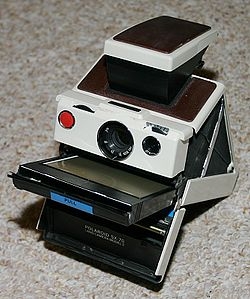- BY Admin
- POSTED IN Articles, Fără categorie
- WITH 0 COMMENTS
- PERMALINK
- STANDARD POST TYPE

The instant camera is a type of camera with self-developing film. The most famous are those formerly made by Polaroid Corporation.
The invention of modern instant cameras is generally credited to American scientist Edwin Land, who unveiled the first commercial instant camera, the Land Camera, in 1947, 10 years after founding Polaroid Corporation.
STORE OF INVENTIONS & TECHNOLOGIES FOR SALE : https://worldwideinvention.com/store/
In February 2008, Polaroid announced it would discontinue production of film, shut down three factories and lay off 450 workers. Sales of chemical film by all makers have dropped by at least 25% per year in this decade, and the decline is likely to accelerate. Fujifilm is now the only remaining supplier of instant film in the United States.
Types of Polaroid instant cameras
Polaroid cameras can be classified by the type of film they use. The earliest Polaroids (pre-1963) used instant roll film, which has since been discontinued. Roll film came in two rolls (positive/developing agent and negative) which were loaded into the camera and eventually offered in three sizes (40, 30, and 20 series). Later cameras utilized “pack film,” which required the photographer to pull the film out of the camera for development, then peel apart the positive from the negative at the end of the developing process. Pack film initially was offered in a rectangular format (100 series), then in square format (80 series). Later Polaroids, like the once popular SX-70, used a square format integral film, in which all components of the film (negative, developer, fixer, etc.) were contained. Each exposure developed automatically once the shot is taken. SX-70 (or Time Zero) film was recently discontinued but had a strong following from artists who used it for image manipulation.
600 series cameras such as the Pronto, Sun 600, and One600 use 600 (or the more difficult to find professional 779) film. Polaroid Spectra cameras use Polaroid Spectra film which went back to a rectangular format. Captiva, Joycam, and Popshots (single use) cameras use a smaller 500 series film in rectangular format. I-zone cameras use a very small film format which was offered in a sticker format. Finally, Mio cameras used Mio film, which was a film format smaller than 600, but larger than 500 series film.
Instant movie cameras
Polavision
Not only did Polaroid make instant still-image cameras, but they also manufactured a type of instant movie camera. The unit was called Polavision. The kit included a camera, film, and a movie viewer. When the movie was shot, it would be taken out of the camera and then inserted into the viewer for development, then viewed after development. This format was close to Super 8 mm film. Polavision film was different from normal film in that it was an additive film, mixing the primary colors (red, green, blue) to form the color image. The biggest disadvantage of the Polavision system was the low film speed (ASA 40), which resulted in having to use very bright lights when taking the movie, as well as requiring a special player to view the developed movie. Because of this, and combined with the advent of VHS video recorders, Polavision had a short history.
Types of non-Polaroid instant cameras
Some of the earliest instant cameras were brought to market before Edwin Land’s invention of the instant camera. These cameras are, however, more portable darkrooms than “instant” camera. After Land’s patent was brought to market, many imitators surfaced, some using Polaroid-compatible film and equipment, such as cameras by Keystone, Konica, and Minolta. Others were incompatible with Polaroid cameras and film, the most notable of these being made by Kodak, such as the Kodamatic. These cameras accepted a Kodak-branded integral instant film, similar to Polaroid’s SX-70 film. Polaroid brought a patent-infringement lawsuit against Kodak, and eventually Kodak was forced to stop manufacture of both the camera and film. Kodak was also left to pay a settlement to some customers who were left without a way to use their now-defunct cameras.
Customers were offered the chance to exchange such Kodak cameras (e.g. the EK160-EF), for one of the new Disc cameras. Although many did make the swap, some did not trust the new disc format, especially in light of the instant picture camera fiasco and held onto their cameras. Possibly in protest or more likely in the hope that they would become rare and valuable as time went by. There are still many thousands available and even in mint condition with all the original booklets, instructions and carrying case they are worth little, and certainly far less than their original 1970s selling price.
Fujifilm
In more recent years, Fujifilm has introduced a line of instant cameras and film in Japanese and Asian markets. Fujifilm called their instant camera line Fotorama. Starting in the early 1980 the F series of cameras include the F-10, F-50S and F-62AF. The mid 80’s introduced the 800 series with models such as the MX800, 850E, and Mr Handy collapsible. The ACE cameras were introduced in the mid 1990’s and film identical to the 800 film but with different cartridge. The integral films are based on the Kodak line of instant camera films. The instant films FI-10/PI-800/ACE series are somewhat compatible with Kodak line of instant cameras, with minor modifications to the cartridge to make it fit. The F series film was discontinued in 1994 but similar modifications on other Fujifilm cartridge box can be made. But there is a difference in ISO film speed, images may appear too washed out or overexposed, without enough control; some cameras may not be able to produce an adequate image. The Fotorama FP series uses peel-apart film like the 100 series compatible with Polaroid models. In the late 1990s Fujifilm introduced a new series of cameras using a new film called Instax it was available in markets outside the US. Instax became available in smaller mini size with the introduction of the Instax mini/Cheki line. The Polaroid’s Mio was available in the US, it uses the same film as the Fujifilm Instax Mini series but were rebranded as Mio film. None of Fujifilm’s products were sold officially in the United States, although the Polaroid-compatible film is available through some larger photographic suppliers. With the announcement in 2008 of Polaroid ceasing film production, the Instax and peel-apart type films are slowly becoming available in more channels.




